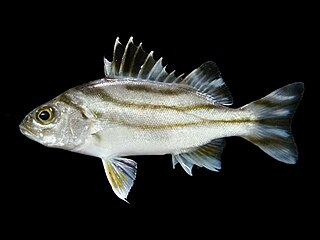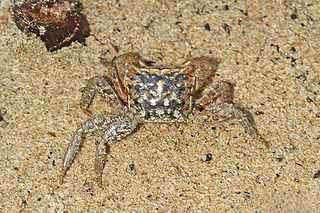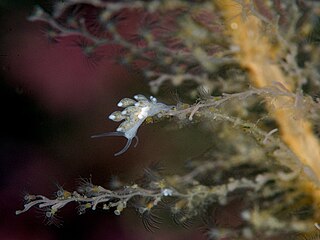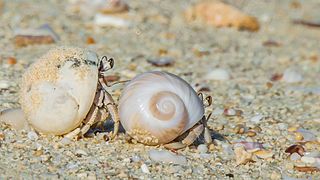
Cymbuliidae is a family of pelagic sea snails or "sea butterflies", marine gastropod mollusks in the superfamily Cymbulioidea.

Peter Forsskål, sometimes spelled Pehr Forsskål, Peter Forskaol, Petrus Forskål or Pehr Forsskåhl was a Swedish-speaking Finnish explorer, orientalist, naturalist, and an apostle of Carl Linnaeus.

Rabbitfishes or spinefoots are perciform fishes in the family Siganidae. The 29 species are in a single genus, Siganus. In some now obsolete classifications, the species having prominent face stripes—colloquially called foxfaces–are in the genus Lo. Other species, such as the masked spinefoot, show a reduced form of the stripe pattern. Rabbitfishes are native to shallow waters in the Indo-Pacific, but S. luridus and S. rivulatus have become established in the eastern Mediterranean via Lessepsian migration. They are commercially important food fish, and can be used in the preparation of dishes such as bagoong.

The Schokari sand racer is a species of psammophiid snake found in parts of Asia and Africa. Psammophis schokari aegyptius has been elevated to species status. Many people refer to snakes in the genus Psammophis as colubrids, but this is now known to be incorrect—they were once classified in the Colubridae, but our more sophisticated understanding of the relationships among the groups of snakes has led herpetologists to reclassify Psammophis and its relatives into Lamprophiidae, a family more closely related to Elapidae than to Colubridae.
Pterotrachea is a taxonomic genus of medium-sized to large floating sea slugs, marine pelagic gastropod molluscs in the family Pterotracheidae, which is in the infraorder Littorinimorpha. As such they are quite closely related to such families as the tritons (Ranellidae) and the tun shells (Tonnidae).

Terapon jarbua, the jarbua terapon, crescent grunter, crescent banded grunter, crescent perch, spiky trumpeter, thornfish or tiger perch, is a species of ray-finned fish, a grunter of the family Terapontidae. It occurs in the Indo-Pacific. it is an important commercial species within its range and is sometimes found in the aquarium trade where it is known as "target fish" for the pattern visible from above.

Uromastyx aegyptia is a species of lizard in the family Agamidae. The species is endemic to North Africa and the Middle East.
Salvia merjamie is a herbaceous perennial plant that is native to the east African highlands from Ethiopia to Tanzania, and also across the Red Sea in Yemen. It grows between 6,000 and 13,000 feet elevation in grasslands, forest edges, rocky outcrops, basalt slopes, and fallow fields. The specific epithet merjamie is derived from meryamiye, the Arabian common name for the plant, which is shared with other local Salvia species such as Salvia lanigera. The Maasai common name for S. merjamie is Naingungundeu, meaning that the plant smells of rats, though the variety that is common in horticulture is named 'Mint Sauce' and is described as having a strong minty aroma. S. merjamie shares a similar distribution with Salvia nilotica, though they are not known to hybridize.

The reticulate whipray or honeycomb stingray is a species of stingray in the family Dasyatidae. It inhabits coastal waters in the western Indian Ocean including the Red Sea, Natal and the Arabian Sea; also a Lessepsian transmigrant in the eastern Mediterranean. A large species reaching 2 m (6.6 ft) in width, the reticulate whipray has a diamond-shaped pectoral fin disc and an extremely long tail without fin folds. Both its common and scientific names refer to its ornate dorsal color pattern of many small, close-set dark spots or reticulations on a lighter background. However, the reticulate whipray is only one of several large spotted stingrays in the Indo-Pacific which, coupled with the variability of its coloration with age and locality, has resulted in a great deal of taxonomic confusion.

The rusty parrotfish is a species of marine ray-finned fish, a parrotfish belonging to the family Scaridae. It is associated with reefs in the north western Indian Ocean and the Red Sea.

The family Cavoliniidae is a taxonomic group of small floating sea snails, pelagic marine opisthobranch gastropod mollusks.

Monodonta nebulosa is a species of sea snail, a marine gastropod mollusk in the family Trochidae, the top snails.

Monodonta is a genus of sea snails, marine gastropod mollusks in the family Trochidae, the top snails.

Metopograpsus messor is a species of grapsid crab that lives in mangroves from East Africa to Fiji.

Tergipes is a genus of sea slugs, specifically aeolid nudibranchs, marine gastropod molluscs in the family Tergipedidae. Tergipes is the type genus of the family Tergipedidae.

Coenobita scaevola is a species of terrestrial hermit crab from the western Indian Ocean and Red Sea.

Tergipes tergipes is a species of sea slug, an aeolid nudibranch, a marine gastropod mollusc in the family Tergipedidae.

Portunus segnis, the African blue swimming crab, is a species of crustacean, a swimming crab belonging to the family Portunidae. While native to the western Indian Ocean, it is also invasive in the Mediterranean. It is thought to have come through the Suez Canal from the Red Sea but it may have been transported by ships.

Siganus stellatus, the brown-spotted spinefoot, brown-spotted rabbitfish, honeycomb rabbitfish, starspotted spinefoot, starspotted rabbitfish or stellate rabbitfish is a species of marine ray-finned fish, a rabbitfish belonging to the family Siganidae. It is found in the Indo-Pacific region.

Cavolinia is a genus of gastropods belonging to the family Cavoliniidae.



















